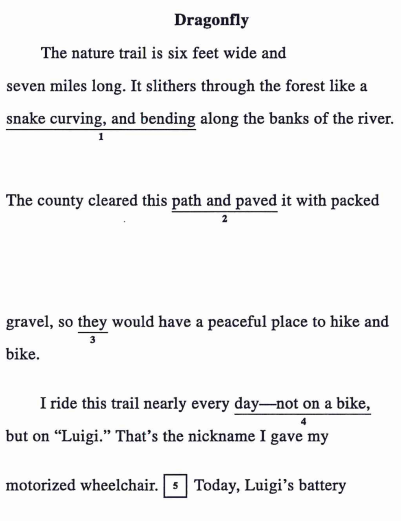Verbal Sample Questions from the SAT and ACT®
Our team of tutors can help you develop strategies to understand these questions and others on your college entry exams.
FOR MORE PRACTICE, SIGN UP FOR A FREE PROCTORED EXAM
ACT® & SAT Sample Questions: English, Writing, & Language
ACT®
Question 1





View Answers
#11 A
#15 B
SAT
Questions sourced from https://app.mentomind.com
Question 1
From a 2023 lecture on cognitive neurology:
The human brain, an intricate web of approximately 86 billion neurons, has often been likened to a supercomputer. But such an analogy, while serviceable for layman’s understanding, falls short of capturing the nuanced dynamics and capabilities inherent to this organic marvel. Unlike silicon-based machines, which function primarily on binary code and set algorithms, the brain’s operations are characterized by plasticity, adaptability, and an almost poetic interplay of electrical and chemical signals. This confluence of factors allows for the emergence of consciousness, emotions, and intricate thought patterns that distinguish humans from mere automatons.
Which choice best describes the function of the underlined sentence in the text as a whole?
- To assert the superiority of the human brain over supercomputers.
- To introduce the topic of how supercomputers work.
- To bridge the common analogy of the brain to a more detailed and nuanced understanding.
- To argue against the use of supercomputers in neurology research.
View Answers
Key Explanation: Choice C is the best answer. The underlined sentence functions as a transitional statement, moving from a widely accepted analogy (brain likened to a supercomputer) to a deeper exploration of the brain’s unique characteristics. By stating that the analogy “falls short,” the text pivots towards a more nuanced discussion of the brain’s capabilities.
Distractor Explanations:
Choice A is incorrect because, while the text does contrast the brain with supercomputers, it doesn’t necessarily assert the superiority of one over the other.
Choice B doesn’t fit as the primary focus of the passage isn’t on the workings of supercomputers.
Choice D is misleading because the text doesn’t discuss or argue against the use of supercomputers in research; it simply contrasts their functions with that of the human brain.
Question 2
In “Artistry in Wood,” author Michael Turner delves into the world of woodworking and its evolution as an art form. Turner emphasizes the significance of choosing the right type of wood for each project. He explains that different woods possess unique qualities that affect the final piece. For instance, oak is known for its durability and is often used for furniture, while cherry is favored for its rich, reddish-brown hue in intricate carvings.
Which choice best expresses the main idea of the passage?
- Woodworking has not evolved significantly as an art form.
- Oak is the only wood suitable for furniture-making due to its durability.
- Michael Turner primarily focuses on intricate carvings in his book.
- The choice of wood plays a crucial role in woodworking and impacts the outcome of the piece.
View Answers
Key Explanation:
Choice D is the correct answer. The passage highlights the central idea that selecting the appropriate type of wood is essential in woodworking and affects the outcome. It mentions the unique qualities of oak and cherry as examples.
Distractor Explanations:
Choice A is incorrect as the passage discusses the evolution of woodworking as an art form.
Choice B is incorrect because the passage doesn’t claim that oak is the only suitable wood for furniture-making.
Choice C is incorrect as the passage doesn’t state that Michael Turner’s primary focus is on intricate carvings.
Question 3
Effective time management is crucial for maintaining a balanced and productive lifestyle. By setting priorities and allocating time to tasks ___________ and can still achieve their goals.
Which choice completes the text so that it conforms to the conventions of Standard English?
- , people can find more opportunities for leisure
- –people can find more opportunities for leisure.
- people can find more opportunities for leisure,
- . People can find more opportunities for leisure
View Answers
Key Explanation: Choice A is correct.
The sentence requires an introductory element followed by a non-restrictive clause to provide additional information about the benefits of effective time management. Using a comma here is appropriate, as it sets off the non-restrictive clause while maintaining the sentence’s coherence.
Distractor Explanation:
Choice B is incorrect because a dash is used incorrectly here. If a dash is used to add extra information, a second dash is needed at the end of the added information.
Choice C is incorrect because it lacks the initial comma required to separate the non-restrictive clause from the rest of the sentence.
Choice D is incorrect because adding a period makes the sentence incomplete and does not make sense on its own.
Question 4
While reading a topic, a student has taken the following notes:
- The cane toad (Bufo marinus) is native to South America, where there are many predators such as caimans, snakes, birds and fish.
- In the 1930s, farmers in Australia were having problems with beetle infestations in their sugarcane fields and wanted to find a solution.
- In 1935, 101 cane toads were imported to eat the beetles, but the population quickly expanded due to a lack of predators, since they contain a toxin that makes them unpalatable.
- Now there are over 200 million cane toads in Australia.
- The Australian government is seeking ways to control the pest without further harming local wildlife.
The student wants to use the cane toad as an example of an invasive species. Which choice most effectively uses relevant information from the notes to accomplish this goal?
- Since cane toads (Bufo marinus) have predators in South America, farmers thought their toxin could control beetle infestations, but unfortunately, the population exploded to over 200 million in Australia.
- Native to South America, 101 cane toads (Bufo marinus) were introduced to Australia in 1935 and the population exploded to over 200 million because there are no predators or effective solutions to keep the population in check.
- Unpalatable to most predators, the cane toad (Bufo marinus) population has grown in Australia even though farmers assumed it would be beneficial in eating beetles that were infesting sugar cane fields.
- The cane toad (Bufo marinus) has predators in South America but not in Australia, where its populations have grown to over 200 million as predators there find it unpalatable.
View Answers
Key Explanation: Choice B is the best answer because the student’s goal is to show an example of an “invasive species,” which refers to species that are not native to an area. Choice B includes the fact that the species is not native to Australia and there is no way to “keep the population in check” or “control the number of toads.” As a result, there is a huge number, and the reader can clearly see the increase.
Distractor Explanations:
Choice A is incorrect because it fails to describe how the species was introduced to Australia, and incoherently links their place of origin to the place which they’ve infested.
Choice C is incorrect because it does not show that the toad came from somewhere else, so the reader does not know it is invasive.
Choice D is incorrect because it does not adequately show how much the population grew or over what time period. It also fails to delineate how and why they were introduced to Australia.
30 ACT® Tips
Download
DOWNLOAD
Comparing the Digital SAT to the ACT®
DOWNLOAD
Resources
Why A+
Test Prep FAQ

A+ News
What They're Saying
Contact Us
A+ Test Prep and Tutoring -- Philadelphia
505 York Road, Suite 6, Jenkintown PA 19046
A+ Test Prep and Tutoring -- Montgomeryville
593-1 Bethlehem Pike, Unit #4, Montgomeryville PA 18936
ACT® and SAT® are registered trademarks belonging to ACT Education Corp. (“ACT”), and College Board, respectively. ACT and College Board are not involved with or affiliated with A+ Test Prep & Tutoring, Inc. nor do ACT or College Board endorse or sponsor any of the products or services offered by A+ Test Prep & Tutoring, Inc.
